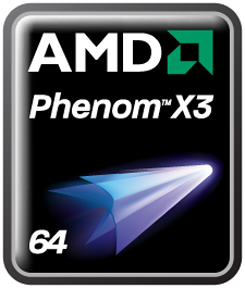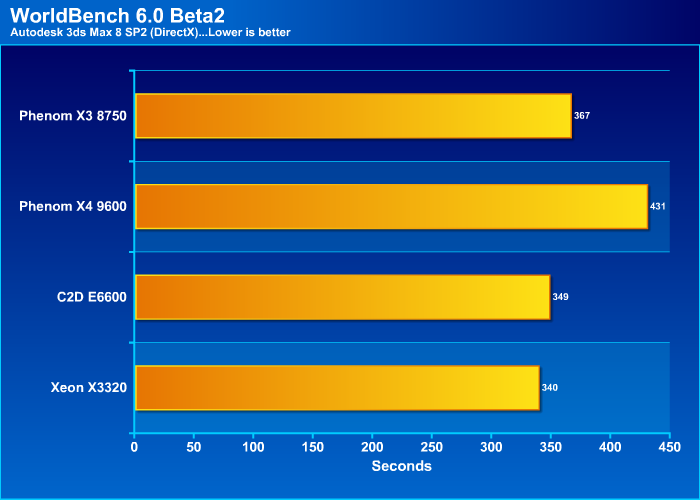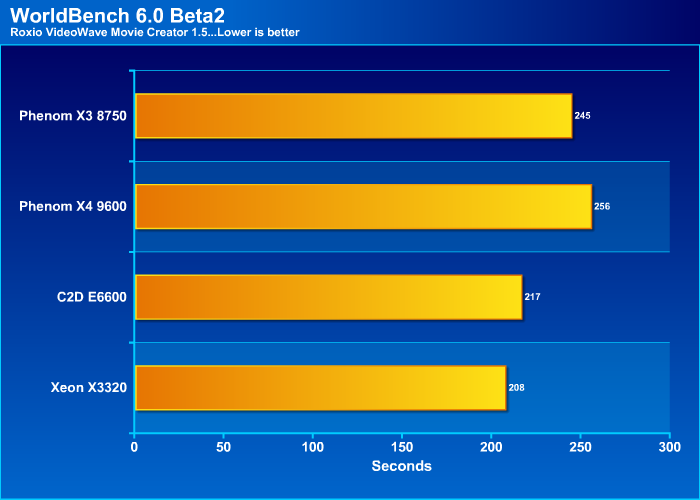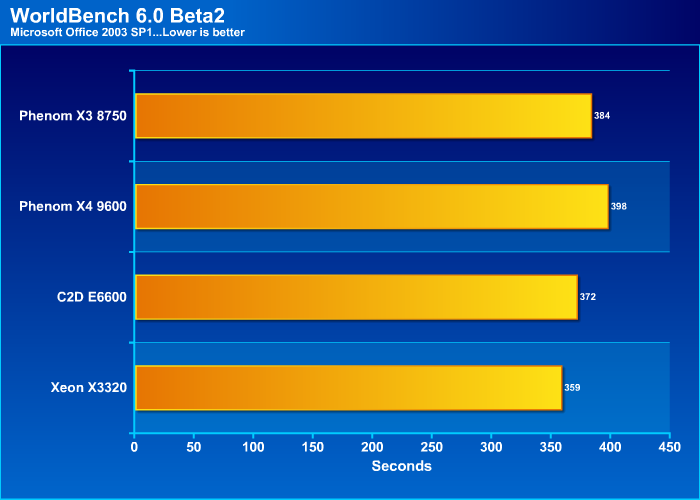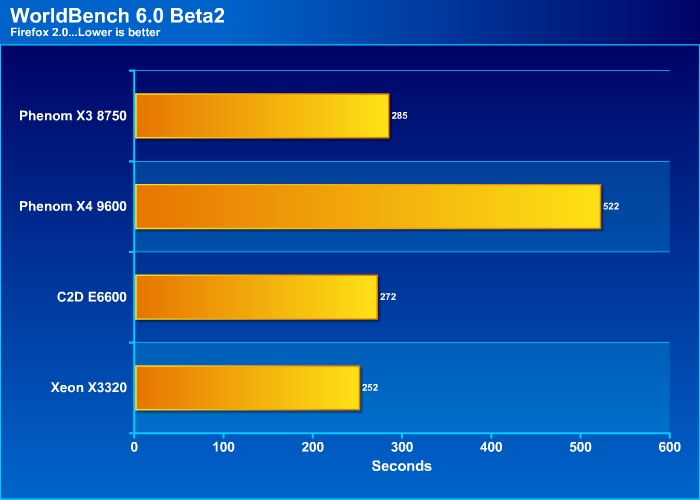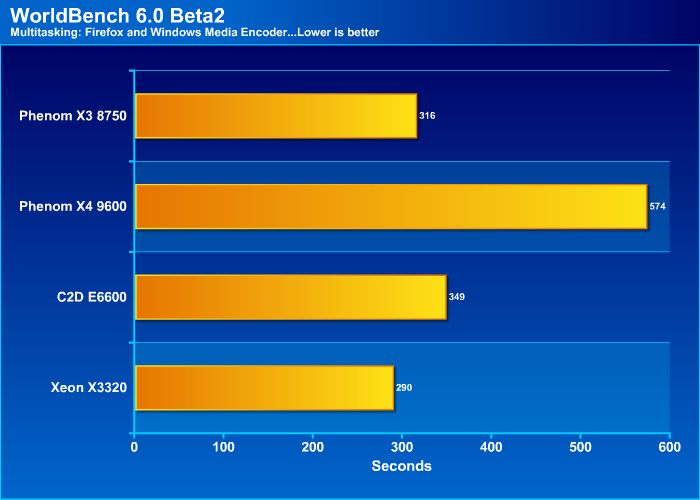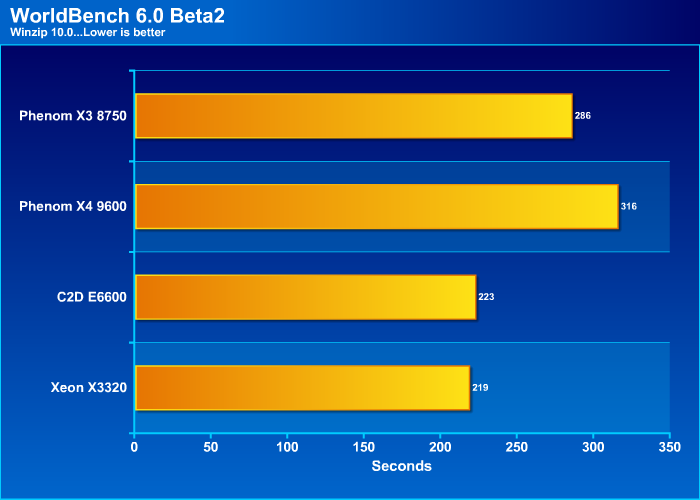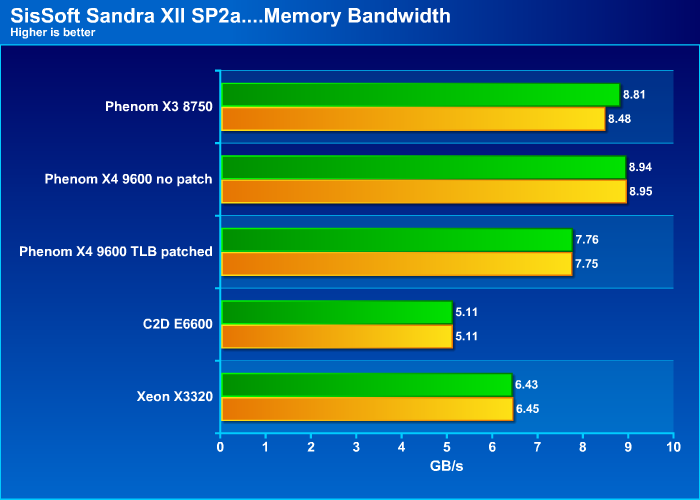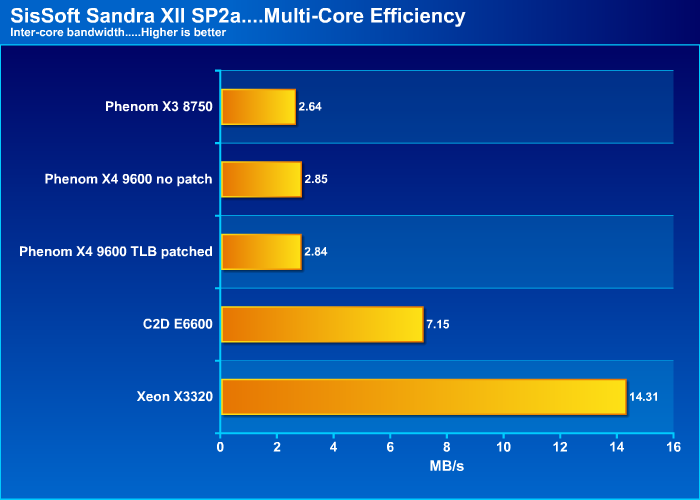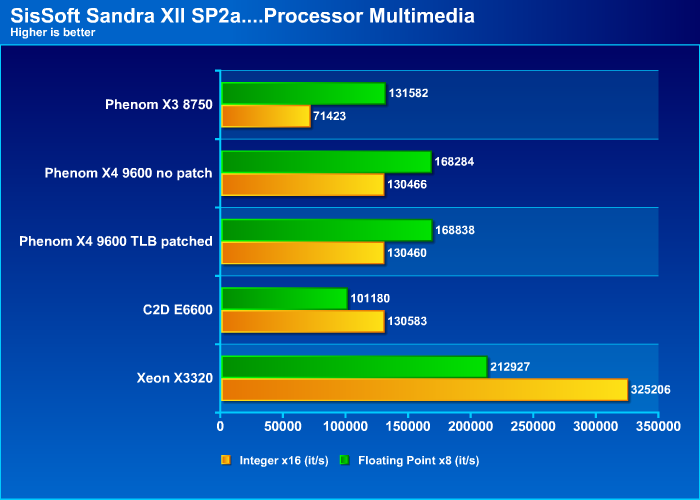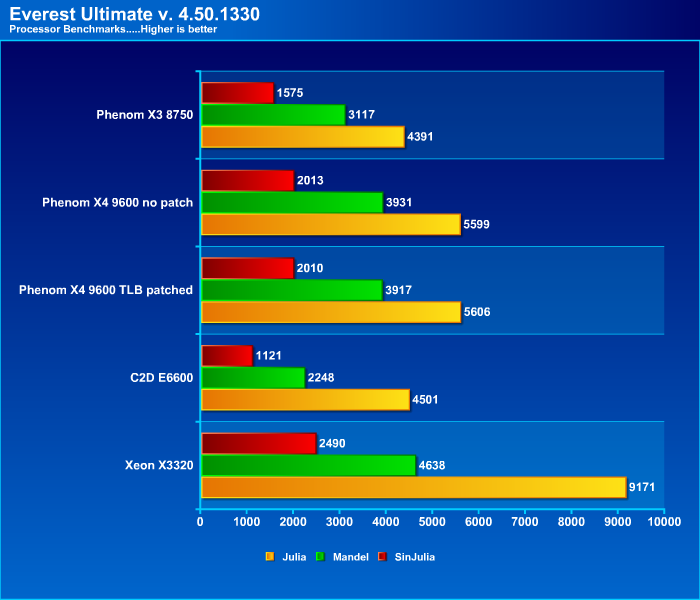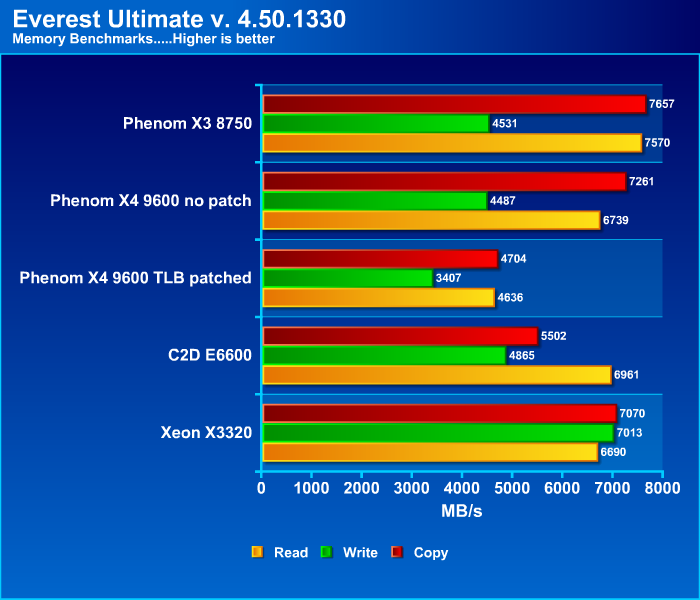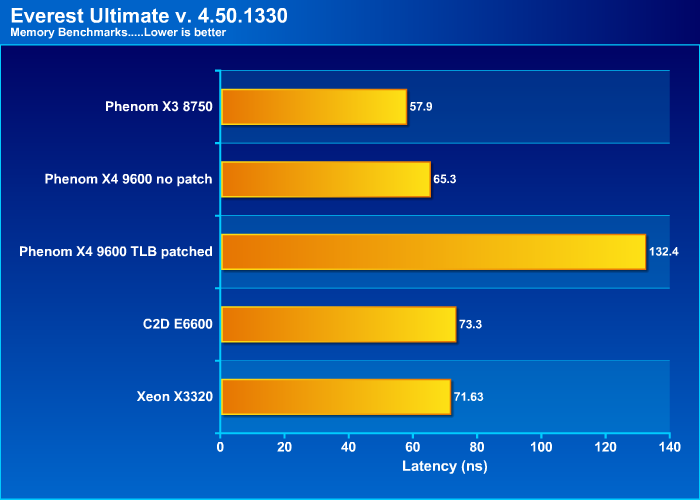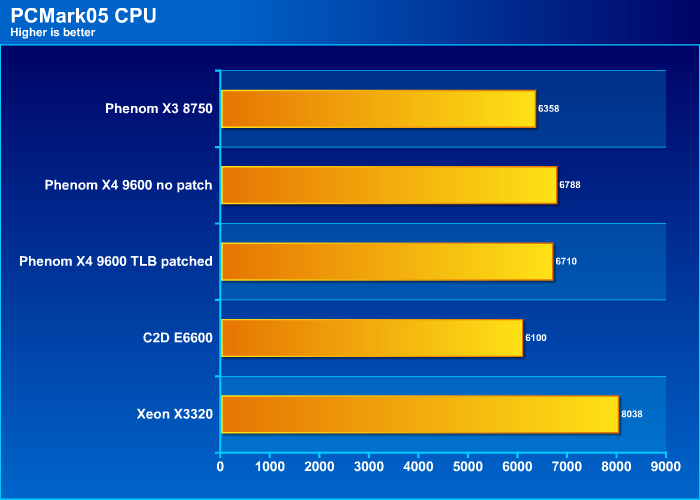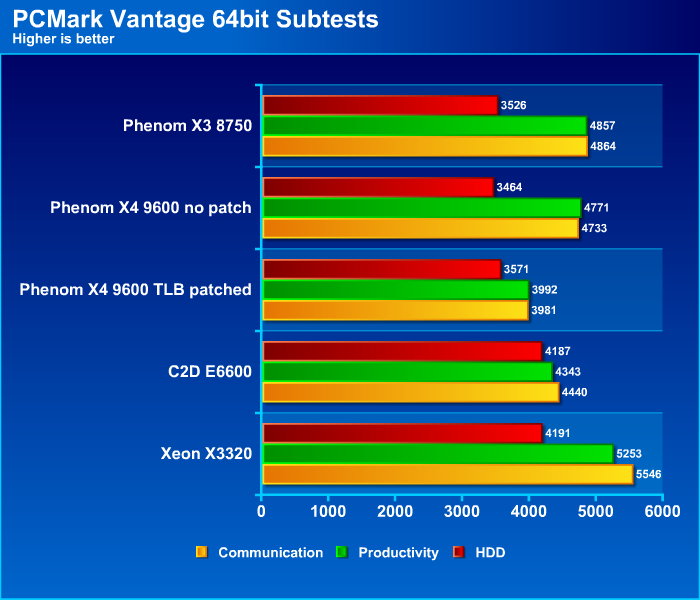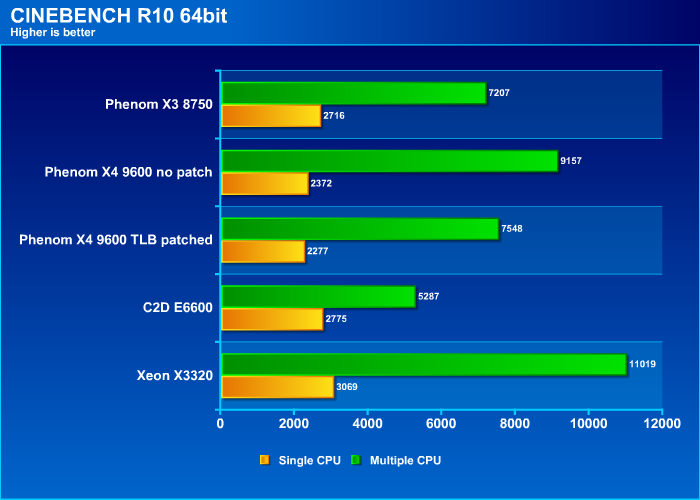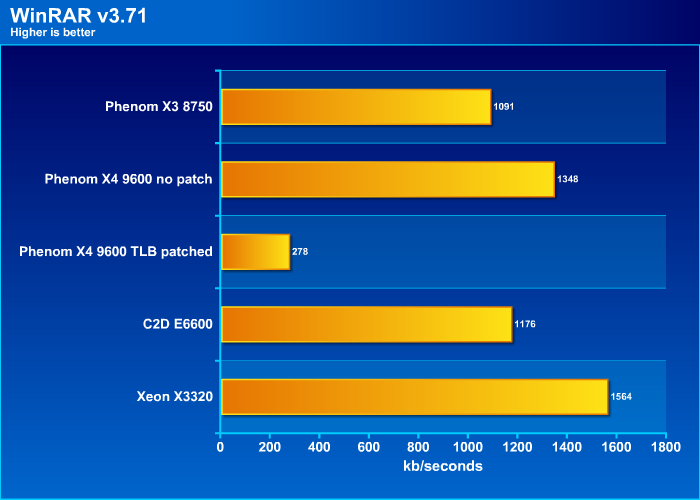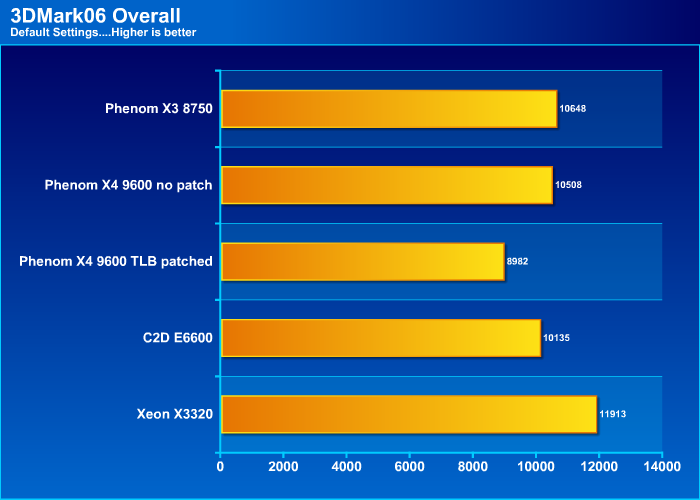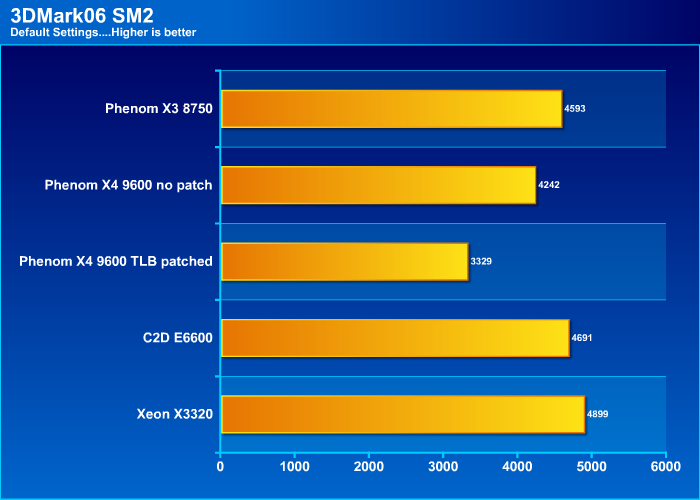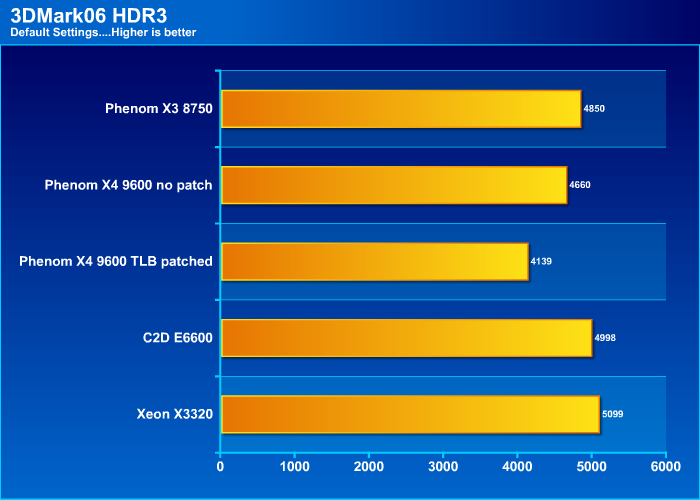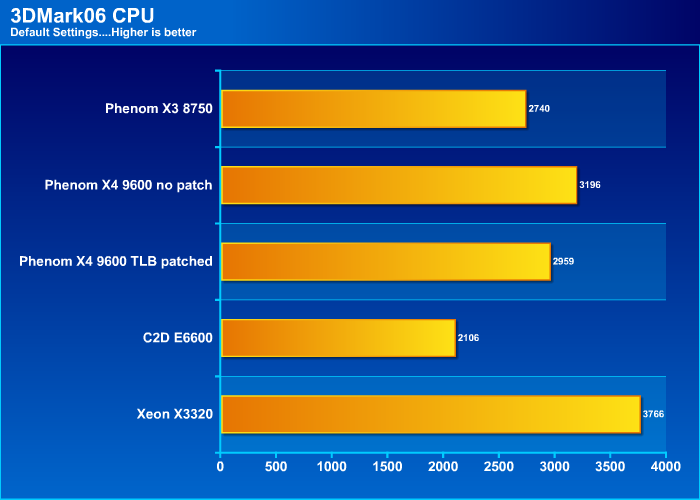Thinking that having more cores would better? That is exactly what AMD is thinking. Today, AMD is once again being the first one on the market releasing the triple-core processor with their Phenom X3 8750. Does this processor can deliver a better performance than the dual-core processors, how does it compares to the quad core processors? Read our review and find out….
INTRODUCTION
Intel has dominated the desktop processor market for a long time. Being they are such a huge giant, it is not easy for any company to fight against them. It is like “David vs. Galiath” and AMD is only remaining player hanging in there to fight against the giant as Via and others provide very little impact anymore.
In order to stay alive, AMD has to be innovative with their products. Remember that they were the first one to offer support for the x86-64with their Athlon X64 processors? Also, they are the first one with the integrated memory controller in their K8 architecture. In fact, the K8 architecture is probably one of the best architectural design from AMD. These innovative technologies not only helped AMD in terms of performance and market-share, they also are superior than many other designs that Intel virtually borrowed them as well. Everyone is familiar with the current Intel processor also offers the x86-64 instruction and Intel’s next generation of processors, Nehalem, will also feature integrated memory controller as well. If you are a fan-boy of AMD, you probably are thinking “copy-cat” but the truth is that Intel is not alone. AMD, in fact, has also borrowed a few technologies from Intel.
Things have been gloomy for AMD for the last couple of years. Just when things start to look good for AMD as they released the K8 architecture, Intel has countered with the Core architecture processors in 2006 which trumped AMD. The subsequent refinement of the Core architecture from 65nm to 45nm has further increased the performance gap while lowering the energy consumption for Intel. Since then, AMD has released Brisbane Athlon 64 X2, virtually a 65 nm AM2 variant of the K8 architecture that offers support for DDR2, which in terms of performance is almost identical to the original Socket 939 K8 processors. Thus, it does not cause any storm to the industry and everybody is waiting for their K10 architecture.
After some rumors of cancellation of K10, AMD has finally released new processors based on the K10 architecture. On September 10, 2007, AMD has finally released the Opteron processor based on the new architecture and shortly after on November 11, 2007, the Phenom processor for desktop was released.
Despite some great improvements with the K10 architecture, the initial Phenom processors (B2 stepping) did not help AMD’s situation at all since they had a nasty TLB erratum. The TLB erratum will cause system lockup under rare circumstances. It is actually as a big issue since the chance of it occurs is prertty rare. However, it is still recommended to patch the errata via BIOS update or the AMD’s own OverDrive. It may not have been as big of an issue if the patch does not cause a huge performance hit (review). Finally, after four month, AMD has released the B3 stepping processors with the TLB erratum fixed. Yet, the new B3 stepping processors still cannot match the performance of the 45nm Core 2 Duo due to much higher clock speed of these processors. And they also face even tougher competition against the Core 2 Quad.
Knowing that they are facing a tough competition, AMD prices their quad core processor at the price similar to the Intel’s Core 2 Duo and low-end Core 2 Quad. Furthermore, AMD once again is being innovative with their product and releases a triple-core processor in hoping to fight the tough battleground that is facing them. Today, join us as we’ll be putting the AMD X3 8750 triple-core processor to the test.
AMD at a Glance
A Leading Global Provider of Innovative Microprocessor and Graphics Solutions
Founded in 1969 and based in Sunnyvale, California, AMD designs and produces innovative microprocessor and graphics and media solutions for the computer, communications, and consumer electronics industries.
Quick Company Facts
- Year Company Started: 1969
- Number of Employees: approximately 16,500
- Headquarters: Sunnyvale, California
- CEO: Hector Ruiz
- Number of Locations: 80
- Revenue: $5.649 billion in 2006
- NYSE ticker symbol: AMD
Innovation
Since the beginning, our focus has gone beyond integrated circuits and transistors. AMD is the informed choice for those who want superior microprocessor and graphics solutions designed from the perspective of the customer. After all, our customers’ success is our success. That’s why AMD products are always developed with customer needs in mind and not for the sake of technology alone. We provide real solutions for real customer problems that exist in the real world today. It’s a philosophy we refer to as “customer-centric innovation,” and it represents the guiding principle behind everything we do.
Vision
We never rest on our laurels. Our passion for what we do compels us to keep looking for the next opportunity to succeed. With corporate locations in Sunnyvale, California; Austin, Texas; and Markham, Ontario; and global operations and manufacturing facilities in the U.S., Europe and Asia, we’re one of the world’s leading integrated circuit manufacturers. We’re also among the market leaders in each of our core businesses: microprocessors and graphics and media solutions for the computer, communications, and consumer electronics industries.
Execution
Because our customers’ needs are ever-changing, AMD understands the value of looking towards—and keeping pace with—the future. To help ensure we meet our customers’ needs today and tomorrow, AMD invests in state-of-the-art technology research many years in advance of first commercial use.
Like other world-class companies, we are proud of our success, but we are never satisfied. At AMD, we are committed to delivering the innovative solutions our customers need, building the framework for sustainable growth going forward.

Brief Overview of Phenom/K10
I am not going to go through extensive detail about what has changed with the K10 architecture, for that you can refer to the excellent overview Bjorn3D has written in the past. To recap, the Phenom processors are built on the K10 architecture and come in dual, tri, and quad cores. On the surface, the K10 looks very similar to the K8 as the AMD K10 is still manufactured at 65nm with Silicon-on-insulator (SOI) technology (with future processors moving to the 45nm). It will work on most Socket AM2 or Socket AM2+ motherboards, however, do check the motherboard manufacturer to see if your board supports it or needs a simple BIOS update in order for it to work with the processor.
However, there are some improvements with the K10 over the K8. The new cores have a 32-byte instruction fetch and 128-bit SSE floating-point loads per cycle. In addition, the new processors have 64K of L1 cache per core, 512K of L2 cache per core, and shared 2MB of L3. In addition, K10 cores also features HyperTransport 3.0 and the integrated memory controller is capable of communicating to DDR2 memory at speeds up to 1066MHz. The new cores also supports SSEa, combined mask-shift instructions (EXTRQ/INSERTQ) and scalar streaming store instructions (MOVNTSD/MOVNTSS).
Furthermore, the new K10 is a “true quad-core” design since all four cores are built into a single chip (as oppose to the Intel’s current quad-core processors which has two dual-cores in a single chip). The new chip also has a better power efficiency as each one of the cores can be clocked independently and can raise or lower their clock speeds depending on the demand. The processors also support split power planes, one for the CPU cores, and the other for the integrated memory controller. However, in order to take the advantage of this feature, AM2+ motherboard is needed.
These improvements make the K10 based processor perform better than the older K8 based processors while keeping the power consumption lower.
AMD PHENOM X3 8000-SERIES PROCESSOR
The new AMD X3 processors are essentially the same as the Phenom X4 quad core processors except with only three cores. All X3 processors will be free from the TLB errata that plagued some of the X4 processors. Those processors (both X3 and X4) with model number ending with 50 will all be free of the errata. In addition, as oppose to the quad-core variant, all X3 will have max TDP of 95W.
AMD prices their Phenom X3 processors at similar price to the current Intel dual core processors in hoping that their extra core can compete with Intel’s extra MHz. They are priced at $195 USD for the X3 8750, $165 USD for the X3 8650, and $145 for the X3 8450. The clock speed of these processors are equivalent as the X4 9×50 with the X3 8750 is clocked at the 2.4GHz, X3 8650 at 2.3GHz, and X3 8450 at 2.1 GHz.
Note, in order for Windows Vista 32bit or Windows Server 2008 to recognize the triple-core processor, a patch must be applied from Microsoft. The file can be requested from Microsoft directly by following the instruction in here. This only effects the 32bit version of the OS and not the 64bit version.
| AMD Phenom Processor Family Technical Specifications |
|
| Model / Processor Frequency | X3 8750 / 2.4GHz X3 8650 / 2.3GHz X3 8450 / 2.1GHz |
| L1 Cache Sizes | 64K of L1 instruction & 64K of L1 data cache per core 384KB total L1 per processor |
| L2 Cache Sizes | 512KB of L2 data cache per core 1.5MB total L2 per processor |
| L3 Cache Size | 2MB |
| Memory Controller Type | Integrated 128-bit wide memory controller configurable for dual 64-bit channels for simultaneous read/writes |
| Memory Controller Frequency | Up to 1.8GHz with Dual Dynamic Power Management |
| Types of Memory | Support for unregistered DIMMs up to PC2 8500 (DDR2-1066MHz) future 45nm processors versions to include support for DDR3 memory |
| HyperTransport 3.0 | One 16-bit/16-bit link @ up to 3.6GHz full duplex (4.0 GHz full duplex for 9700 & 9900 Processors) |
| Total Processor Bandwidth | Up to 31.5 GB/sec bandwidth |
| Packaging | Socket AM2+ 940-pin organic micro pin grid array (micro-PGA) Phenom processors are backward-compatible with Socket AM2 motherboards |
| Fabrication Location | AMD’s Fab 36 wafer fabrication facilities in Dresden, Germany |
| Process Technology | 65nm (.065-micron) Silicon on Insulator (SOI) |
| Approximate Transistor Count | ~ 450 million (65nm) |
| Approximate Die Size | 285 mm2 (65nm) |
| Max Ambient Case Temp | 70 Celsius |
| Nominal Voltage | 1.05-1.25 Volts |
| Max TDP | 95 Watts |
TEST METHOLOGY
We will be putting the Phenom X3 8750 clocked at 2.4 GHz against the Intel E6600, which also clocks at 2.4 GHz. This will give a direct comparison of the two processors at the same speed. In addition, we will throw in the X4 Phenom 9600 and Xeon X3320 into the mix to show the performance difference between the triple core against the current quad core processors at a similar price range.
|
TEST PLATFORMS |
||
|
Element |
AMD |
Intel |
|
Processor |
X4 Phenom 9600 2.3 GHz |
Xeon X3320 2.5 GHz |
|
CPU HSF |
AMD Standard with 4 heatpipes |
Standard Intel Heatsink |
|
Motherboard |
Asus M3A32-MVP Deluxe |
Gigabyte EX38-DS4 |
|
Memory |
OCZ DDR2 PC2-8500 Reaper HPC 4GB Edition @ 1066MHz with 5/5/5/18 timings (2T) |
|
|
Drive(s) |
Samsung HD501LJ 500GB/7200rpm/16M Cache |
|
|
Graphics |
XFX Fatal1ty 8800 GTS 320MB Forceware 169.25 |
|
|
Power Supply |
Zalman ZM460-APS |
|
|
Case |
None |
|
|
Operating System |
Windows Vista Ultimate SP1, 64bit |
|
Benchmarks:
- World Bench 6.0 Beta 2
- Futuremark 3DMark06
- Futuremark PCMark05
- Futuremark Vantage
- Cinebench R10
- Sisoft SANDRA XII SP2
- Everest Ultimate Edition v. 4.50.1330
- Super PI mod 1.5XS
- Company of Heroes v. 171
- Crysis
- WinRar v3.71
Test notes:
Our Phenom X4 processor has the B2 stepping along with the TLB errata. AMD has urged all motherboard manufactures to release a BIOS to patch the TLB errata and our Asus M3A32-MVP Deluxe’s latest bios 0801 has the patch enabled. The patch can still be disabled with AMD’s own OverDrive software and we will be using the software to disable the patch during the benchmarks. Since AMD urges users to patch the errata, we also run the benchmarks with the patch enabled to show the performance difference among the processors.
Asus M3A32-MVP Deluxe would be our board for the test.
TEST RESULTS
WorldBench 6.0 Beta 2
WorldBench 6.0 Beta 2 is an updated version of the ever popular World Bench 5. It uses series of real-world benchmarks which includes a wide variety of applications scripted to test your system’s performance. Once all the tests are completed a single score is rendered with higher scores showing improved performance. We decided to publish the individual test results of WorldBench 6.0 Beta2 in lieu of reporting a single score which gives little or no meaning as to where the shortcomings of your system are. Our results from WorldBench do not include patched and unpatched results as there was little or no difference noted.
Also, note that the result for the Phenom X4 9600 is taken with the TLB errata patch applied. The results from WorldBench is pretty much self-explanatory.
The Phenom X3 8750 is still unable to overtake the Intel’s dominance in the 3D applications. Having multiple core sure helps as we can see the Phenom X3 is able to out-perform the E6600. However, Intel is clearly having the advantage here. In most benchmarks, we can clearly see the year and half old dual core E6600 actually offering a much better result than the Phenom X3.
Surprisingly, the Nero burning shows that quad core processors are running slower than the dual or triple cores.
TEST RESULTS
WorldBench 6.0 beta 2, con’t
The TLB errata patch has significantly reduced the performance of Firefox. It’s good to see that the Phenom X3 has fixed the issue and is able to offer at least a comparable performance.
Multitasking is something where having that extra core will definitely come in handy.
TEST RESULTS
SisSoft Sandra XII SP2a
“SiSoftware Sandra (the System ANalyser, Diagnostic and Reporting Assistant) is an information & diagnostic utility. It should provide most of the information (including undocumented) you need to know about your hardware, software and other devices whether hardware or software.” Sandra has been a mainstay benchmark used by the vast majority of computer enthusiasts around the world for benchmarking their systems for as long as we can remember.
AMD’s integrated memory controller is always able to offer a better memory bandwidth than Intel. Here we can see the how much the TLB errata really affects the performance.
The Phenom X3’s Integer x16 lags behind the Core architecture. Even with Phenom X4, it is still not able to out perform the E6600. However, the floating point x8 for the Phenom processors scales fairly well with the additional core.
TEST RESULTS
Everest Ultimate v 4.50.1330
“EVEREST Ultimate Edition is the cutting-edge benchmarking and diagnostics tool to maximize security, performance, and trouble-shooting capabilities for home and home office PC environments, PC Professionals and consulting firms as well as OEM partners and Configuration Centers worldwide.” Everest Ultimate Edition has been around for several years now and has over the last several versions gained huge credibility amongst the enthusiast sector. Everest Ultimate Edition offers several CPU and FPU benchmarks that are unlike others on the market and quite good.
Processor Benchmarks
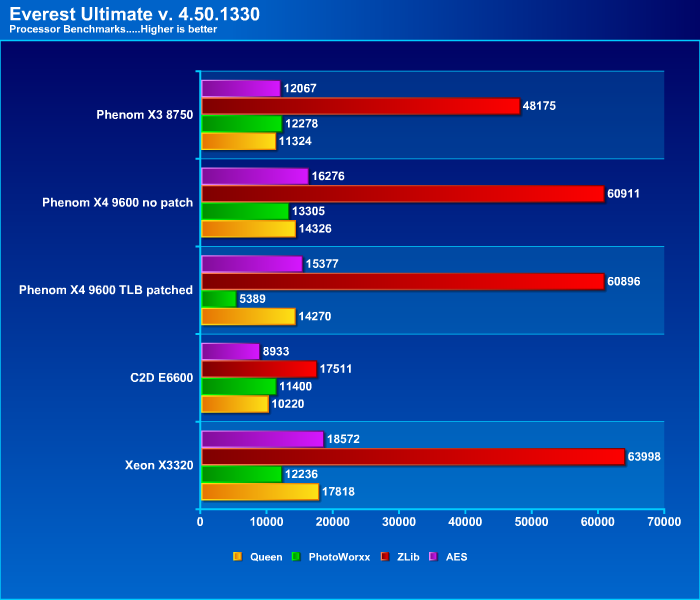
Memory Benchmarks
In Everest’s memory benchmarks, we can clearly see the effect of the TLB patch on the Phenom processors. In addition, we can see that the Phenom X3 has a better performance than the unpatched Phenom X4.
SuperPI Mod 1.5XS
“SuperPI is a computer program that calculates pi to a specified number of digits after the decimal point – up to a maximum of 32 million. It uses Gauss-Legendre algorithm and is a Windows port of the program used by Yasumasa Kanada in 1995 to compute Pi to 232 digits. Super Pi is used by many overclockers to test performance and stability of their systems. In this community, Super Pi has become the standard for providing benchmarks to compare pi calculation times and demonstrate their overclocking skills.” The version used in our testing mod 1.5XS has been modified by Xtreme Systems and we feel is the best version currently available.
Intel dominates the benchmark here. Even the E6600 is able to offer a far better result than the Phenom X3.
TEST RESULTS
PCMark05
PCMark05 developed by Futuremark is a synthetic benchmark much like its 3DMark06 counterpart. PCMark05 differs from 3DMark06 in that it is not graphics specific. PCMark05 also looks at the rest of your system components including your CPU, memory, disk drives, as well as your system’s graphics capabilities. PCMark05 offers a default suite of results as well as separate suites specific to the previously mentioned components. We opted to use the default suite of results as well a CPU suite for our testing.
PCMark Vantage
PCMark Vantage is the updated version of the PCMark05. It adds more updated benchmark applications for the test. In addition, it also offers support for multi-threaded applications and multi-core processors, as well as 64bit Windows Vista. We will be running the benchmark using the 64bit version.
In PCMark Vantage, the performance of Phenom X3 8750 is almost identical to the Phenom X4 9600 without the TLB patch. In addition, the Phenom X3 is able to offer a slightly better performance than the E6600 which is at the same clock speed.
TEST RESULTS
CINEBENCH R10
CINEBENCH is a real-world test suite that assesses your computer’s performace capabilities. CINEBENCH runs several tests on your computer to measure the performance of the main processor and the graphics card under real world circumstances. The benchmark application makes use of up to 16 CPUs or CPU cores and is available for Windows (32-bit and 64-Bit) and Macintosh (PPC and Intel-based). The resulting values among different operating systems are 100% comparable and therefore very useful with regard to purchasing decision-making.
CINEBENCH shows that at same clock speeds, the performance for the processors are pretty much identical for the single CPU benchmark. The X3 8750 scales fairly well in the multiple core benchmarks, offering 2.65 times of the performance.
WinRAR
WinRAR is a popular archive manager from Gmbh. It has a built in benchmark program that can assess the performance in terms of kb/s.
Phenom X3 shows a tad lower performance compare to the dual-core E6600. This is application clearly has a huge effect from TLB patch.
TEST RESULTS
3DMark06
3DMark06 developed by Futuremark is a synthetic benchmark used for universal testing of all graphics solutions. 3DMark06 features HDR rendering, complex HDR post processing, dynamic soft shadows for all objects, water shader with HDR refraction, HDR reflection, depth fog and Gerstner wave functions, realistic sky model with cloud blending, and approximately 5.4 million triangles and 8.8 million vertices; to name just a few. The measurement unit “3DMark” is intended to give a normalized mean for comparing different GPU/VPUs. It has been accepted as both a standard and a mandatory benchmark throughout the gaming world for measuring performance.
Overall, triple and quad core processors are able to out-perform the duo core, Core 2 Duo E6600.. With 3Dmark06, we see virtually no difference in triple or quad cores for the Phenom processors.
Surprisingly, the 100MHz higher clocked Phenom X3 actually has better result in both SM2 and HDR3 benchmarks. However, Intel still dominates here though, with E6600 out performs either triple or quad core processors from AMD.
TEST RESULTS
World in Conflict v1.007
World in Conflict is one of the real-time strategy game from Massive Entertainment. It features the Masstech Engine developed by the Massive Entertainment. Many of the real-time strategy games are very CPU dependent and this game puts a faily high demand on the processor and graphic cards. Thus, it will serve a great benchmark for the processor’s performance.
Looks like WiC is not able to take the advantage of the triple or quad core. Many games on the market are not really written to take the advantage of the processors with more than two cores yet, it’s a shame though. It looks like this game is highly depended on the raw clock speed than number of cores.
Crysis v1.21 64bit
Crysis is the most highly anticipated game to hit the market in the last several years. Crysis is based on the CryENGINE™ 2 developed by Crytek. The CryENGINE™ 2 offers real time editing, bump mapping, dynamic lights, network system, integrated physics system, shaders, shadows and a dynamic music system just to name a few of the state of-the-art features that are incorporated into Crysis. As one might expect with this number of features the game is extremely demanding of system resources, especially the GPU. We expect Crysis to be a primary gaming benchmark for many years to come.
Crysis has built in CPU and GPU benchmarks and we will run both benchmarks at medium global setting with 0AA and 0AF. We ran the 64bit version of the benchmark at 1280×1024 resolution with the Crysis Benchmark Tool from Guru3D.
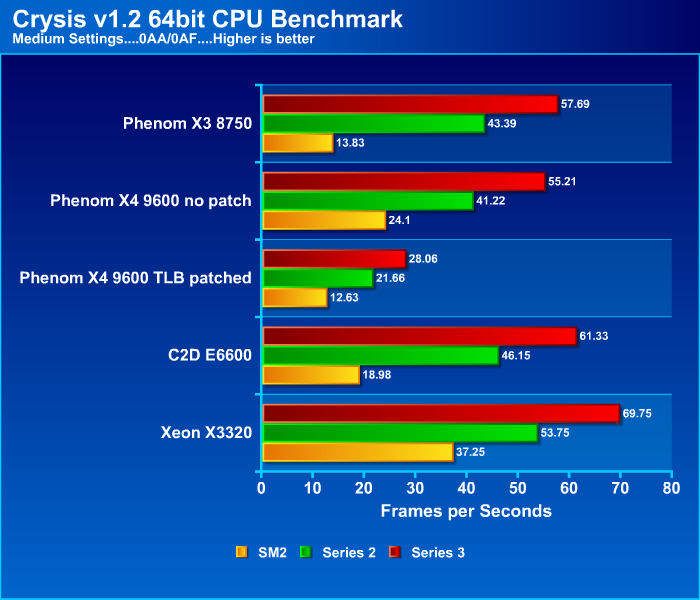
Intel is clearly the winner here. Once again, the extra 100MHz seems to help the X3 8750 to score a better fps than the X4 9600 though it is still not enough to overtake E6600 from Intel.
OVERCLOCKING
Overclocking Phenom processors is not as easy as Intel system or the old Athlon 64 because AMD has integrated a Northbridge that runs at its own frequency. It just adds a little extra thing which we must watch out, the Northbridge frequency, in addition to the processor frequency, memory frequency and HyperTransport. Luckily the Asus M3A32-MVP Deluxe which we used in the review has all the goodies for overclocking.
Basically with Phenom, you would have to keep the following equations in mind:
- CPU Frequency = CPU Multiplier x FSB Frequency
- HT Frequency = HT Multiplier x FSB Frequency
- NB Frequency = NB Multiplier x FSB Frequency
- Memory Frequency = Memory Divider x FSB Frequency
So, as you can see changing the FSB frequency alone will have a dramatic effect on all the frequencies. The Phenom processors (with the exception of the X4 9850) all have the HT frequency and NB frequency of 1800 MHz. While overclocking the FSB, make sure that the HT and NB multipliers are lowered in order to keep these frequencies close to 1800 MHz in order to get a stable system.
Since the Phenom X3 8750 has the CPU multiplier locked, the only way to overclock is to raise the FSB frequency. Overclocking Phenom processors has turned into a very disappointing result. We could only overclock the processor to 230 MHz FSB and yielding a processor speed of 2.76 GHz. This is only about 15% increase from the 2.4 GHz. In the old days this may seem like a lot but with current Wolfdale overclocks like crazy it just does not cut it. It seems like none of the current Phenom processors, both quad cores and triple cores, are capable of breaking the 3GHz barrier and most of them can only be overclocked around 2.8 GHz. This is probably why we do not see higher clock speed Phenom from AMD at all.
While this is purely speculation but I suspect this could be the architecture limitation of the Phenom processors and possibly due to the integrated Northbridge and memory controller. I highly doubt that it is heat that is causing the low overclocking result because even at 2.76 GHz the processor is still running fairly cool at temperature below 50 degree C.
It is quite a shame to see such low overclocking results as the Phenom needs to be clocked much higher in order to really out-perform the 45nm Intel processors (and these processors can really be clocked close to 4GHz without breaking a sweat). Hopefully, once AMD moves to 45nm fabrication process, we will see a higher clock processor and better overclocking results.
POWER CONSUMPTION
The system power consumption is measured with Kill-A-Watt P4400. All the power saving features (Cool & Quiet, SpeedStep, etc) are enabled under the BIOS. We test each system’s power consumption by running the CINEBENCH benchmark. Since CINEBENCH is able to test single CPU and multiple CPU, we will report the power consumption under both conditions to see how much extra power is needed when all cores are running. The idle setting is measured with system booting into Windows without any program running in the background.
Do keep in mind that the power consumption is overall system power consumption and since we have to use two different motherboards, it is not a direct comparison of the processors.
Power consumption clearly works against AMD Phenom processors. We see that Phenom X3 8750’s idle power consumption is higher than the Intel C2D E6600 under load. Compare the X3 8750, we see that it consumes a whopping 52 W more than E6600 and 37 W more than the X3320. The X3 and X4 Phenom’s power consumption is almost identical to each other. Despite higher power consumption, all quad and triple core processors from both Intel and AMD seem to only consume about 20 more watts of power when all cores are working at maximum speed. It is also interesting to see that the patched Phenom X4 9600 actually consumes more power than the unpatched.
CONCLUSION
The road ahead of AMD looks even challenging with the release of the Phenom X3. We put it against a year and half old E6600 processor that runs at the same clock speed as the X3 8750 and the results shows that in day-to-day applications, it hardly performs better. In the benchmarks where we did see a performance increase it was usually small unless the application is heavily threaded. It is no surprise that the Phenom X3 clearly has the advantage with multi-tasking and multi-threaded applications. Unfortunately, at the present moment, not many applications are yet to support it well enough to really recommend choosing this processor over the E8400, which sells at similar price but will have a better performance than the X3 8750. In fact for those who use applications that are multi-threaded, it is worth to spend a few extra bucks and go for the quad core processor, such as Phenom X4 or the Q9300, as the performance gain is definitely better than the X3 Phenom. This lack of support for multiple-cores in the software is not AMD’s fault but nonetheless, it is something which users should be aware of.
Not only that AMD is not winning in the performance, it also is losing the ground in the power consumption arena as well. To really have some impact against Intel processors, AMD needs to have a faster clock speed but as our overclocking indicates, it seems like current Phenom processors are limited to 2.8 GHz and at this speed with Intel 45nm processors capable of running at 3 GHz and higher, the Phenom X3 sure is facing a stiff competition
That being said, this does not mean that AMD Phenom X3 is a bad processor. In fact, the triple-core Phenom is a nice idea and it is good to see that AMD sticks with the AM2+ socket (at least for now) because it will offer customers with older Athlon64 X2 processor to upgrade to the triple-core version without a major system upgrade. The K10 architecure scales quite well with multiple-cores, consumes less power than the older Athlon 64 X2, and performs better. However, it would be hard to recommend any one who may already have a somewhat new Intel system with C2D (even the older 65nm version) to switch to the triple core simply for the extra core at the moment.
Pros:
+ Supports current AM2+ motherboard
+ Triple-Core
+ TLB errata fixed
+ Excellent memory management and bandwidth
+ Good performance if the applications are multi-threaded
+ Has potential
Cons:
– Performance is not as great as one would hope for
– Does not overclcok well
– Power consumption is higher than the competitor
Final Score: 7.5 (good) out of 10.
 Bjorn3D.com Bjorn3d.com – Satisfying Your Daily Tech Cravings Since 1996
Bjorn3D.com Bjorn3d.com – Satisfying Your Daily Tech Cravings Since 1996
